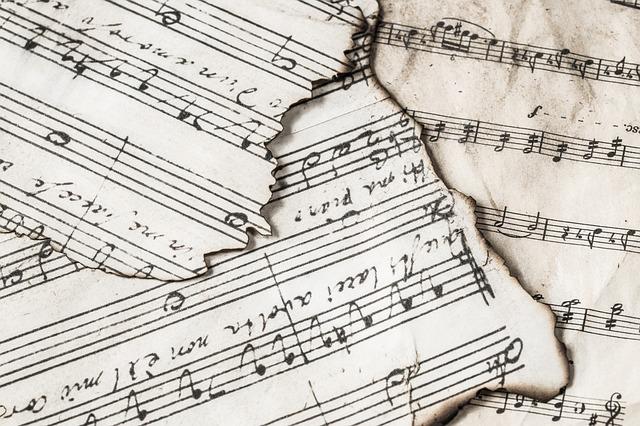Have you ever found yourself captivated by the sweet strains of a melody, watching musicians effortlessly translate their emotions into sound? If so, you’re not alone! Music has a magical way of touching our hearts, but what if you could dive deeper and understand the language behind the notes? Imagine being able to decode sheet music like a secret treasure map, guiding you to create your own symphonies. In this article, “,” we’ll explore the fundamentals of music notation, demystifying this beautiful art form. Whether you’re a budding musician itching to learn an instrument or simply want to appreciate music on a deeper level, this guide is designed just for you. So grab your imaginary conductor’s baton, and let’s embark on this harmonious journey together!
Exploring the Basics of Musical Notation
Understanding musical notation is like learning the language of sound; it’s a pathway to expressing a world of emotions through creativity. At its core, musical notation involves a set of symbols that tell musicians how to play a piece of music. The foundation of this language lies on the staff, which consists of five lines and four spaces. Each line and space represents a different pitch, giving you a unique roadmap for where to place your fingers or how to embolden your voice. Here are the essential elements you’ll encounter:
- Notes: These are the symbols that indicate sound, with varied shapes and colors to represent different pitches and rhythms.
- Clefs: The symbols at the beginning of the staff that determine the pitch range—like a compass guiding you through musical territory.
- Rests: Indicate silence in music, reminding you that pauses are just as crucial as the notes themselves.
To make sense of it all, let’s peek into some foundational concepts to ensure you get started on the right foot. Often, the treble clef is the first you encounter, famously wrapping around the second line, which signifies the note G. Conversely, the bass clef indicates a deeper range and encapsulates the lower notes. Want a clear snapshot? Check out the table below:
| Clef | Notes on Lines | Notes in Spaces |
|---|---|---|
| Treble Clef | E, G, B, D, F | F, A, C, E |
| Bass Clef | G, B, D, F, A | A, C, E, G |
By getting familiar with these symbols and their meanings, you’ll only scratch the surface of what’s to come. Musical notation invites you to dive deeper into structure and rhythm, opening new windows to creativity that you may not have thought possible. As you learn to read and interpret these notes, you’ll find that each piece of music tells its own story, urging you to unlock your unique expression.
Understanding the Symbolic Language of Music

Music is often described as a universal language, and just like any language, it has its own set of symbols and rules. Understanding how these symbols convey emotions and ideas is essential for anyone looking to dive into the world of music. Picture a musical score as a map, guiding you through the landscape of sound. Each note, rest, and dynamic mark tells a story, and when you learn to read it, you unlock the ability to interpret and express those stories yourself. Here’s a glimpse into some of the fundamental symbols you’ll encounter:
- Notes: Represent the pitch and duration of a sound.
- Rests: Indicate silence, allowing for a pause in the music.
- Clefs: Define the pitch range for the notes; think of them as the anchor for your musical journey.
- Dynamics: Guide the volume of the music, telling you when to play softly or with force.
One of the most fascinating aspects of musical notation is how it can evoke imagery and feelings. For example, a crescendo might feel like the swelling tide of the ocean, while a sudden fermata could resemble a frozen moment in time—capturing a feeling for just an instant. To illustrate how these symbols come together, consider the simple table below, which highlights how different elements interact in a score:
| Symbol | Meaning | Effect |
|---|---|---|
| ♩ | Quarter Note | Steady beat; the heartbeat of the song. |
| 𝄞 | Treble Clef | Signifies higher sounds, like a bird soaring. |
| ≥ | Crescendo | Builds excitement, like a roller coaster climbing. |
As you explore these symbols and their meanings, you’ll find that learning to read music is not just a practical skill; it’s a key to deeper creative expression.
Essential Tips for Mastering Rhythm and Melody

Mastering rhythm and melody is akin to learning a new language, where pauses and inflections can convey a world of meaning. To keep things flowing smoothly, focus on the beat. Start by tapping your foot along to your favorite songs or using a metronome. Remember that rhythm isn’t just about keeping time; it’s about feeling the music within you. Try clapping out different rhythms or using percussion instruments to internalize the beat. Once you’ve got your sense of timing down, embrace the melody. Practice singing simple scales or playing them on your instrument. This not only makes it easier to recognize melodies but also builds muscle memory, which is essential. Think of melodies as the storylines of your favorite films—every note contributes to that emotional arc.
Another valuable technique is to isolate and analyze different sections of a piece. Break down songs into smaller chunks, focusing on how the rhythm complements the melody. You might find it helpful to write down any interesting patterns you discover. When you start recognizing these patterns, you’ll feel more equipped to create your own music. Consider keeping a practice log where you jot down your progress and insights; this will help track your rhythm and melodic achievements over time. As you dive deeper, explore different styles and genres; jazz may infuse a swing rhythm into your repertoire, while classical might emphasize elegance. Variety in your practice keeps things fresh and exciting, so go ahead, switch it up!
Building Your Practice Routine for Successful Reading

Creating a practice routine that fits your personality and learning style can be a game-changer when you’re diving into the world of music. Think of your practice time as a treasure map; every note you learn is like a step toward discovering a hidden gem. To start, consider breaking your practice into bite-sized chunks. This might mean focusing on one or two elements at a time, such as rhythm and pitch. Feel free to mix methodologies as you go along! Here’s a simple list to guide your practice:
- Warm-Up: Spend 5-10 minutes on finger exercises or vocal warm-ups.
- Scales: Work through major and minor scales—this builds your ear and technique.
- Sight Reading: Pick a new piece every week; it’s like a workout for your reading skills.
- Review: Go over what you learned in previous sessions to reinforce memory.
- Cooldown: Finish with something you enjoy playing or singing.
| Time | Activity |
|---|---|
| 5-10 min | Warm-Up |
| 10-15 min | Scales |
| 10 min | Sight Reading |
| 10 min | Review |
| 5-10 min | Cooldown |
As you develop your routine, remember that quality trumps quantity. It’s better to practice mindfully for a shorter period than to drag out a session and lose focus. Consider setting aside dedicated time slots throughout the week to build consistency. You know how a good cup of coffee needs the right ingredients to brew just right? Well, your practice routine works in much the same way! Clarity and intention will enhance your skills more effectively than aimless strumming or ticking off checkboxes. Get ready, because each note you master paves the way for the next, leading you one step closer to your musical aspirations.
To Wrap It Up
As we wrap up this adventure into the world of music notation, think of reading music as opening a treasure chest filled with endless possibilities. Just like any skill worth mastering, it takes practice, patience, and a sprinkle of passion. Remember, every great musician started as a beginner, peering into the notes and wondering what magic lay within.
So, if you’re standing on the threshold of your musical journey, take a deep breath and dive in! Each note you decipher is a step closer to creating your own symphony, whether that’s in your living room or on a grand stage. Don’t shy away from mistakes; they’re simply stepping stones to mastery. With the right tools and a bit of determination, you’ll not only unlock the notes but also discover a whole new language that speaks straight to the soul.
Now, grab your instrument, revisit those notes, and let the music flow. Your journey has just begun—let the melodies guide you!



